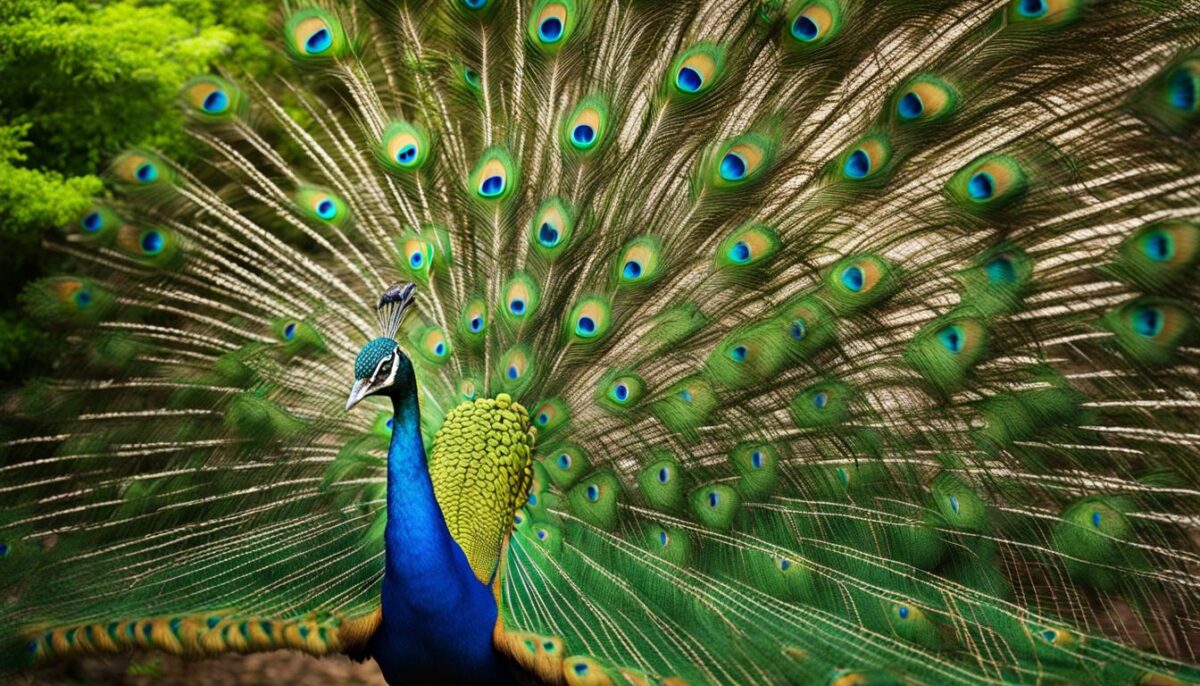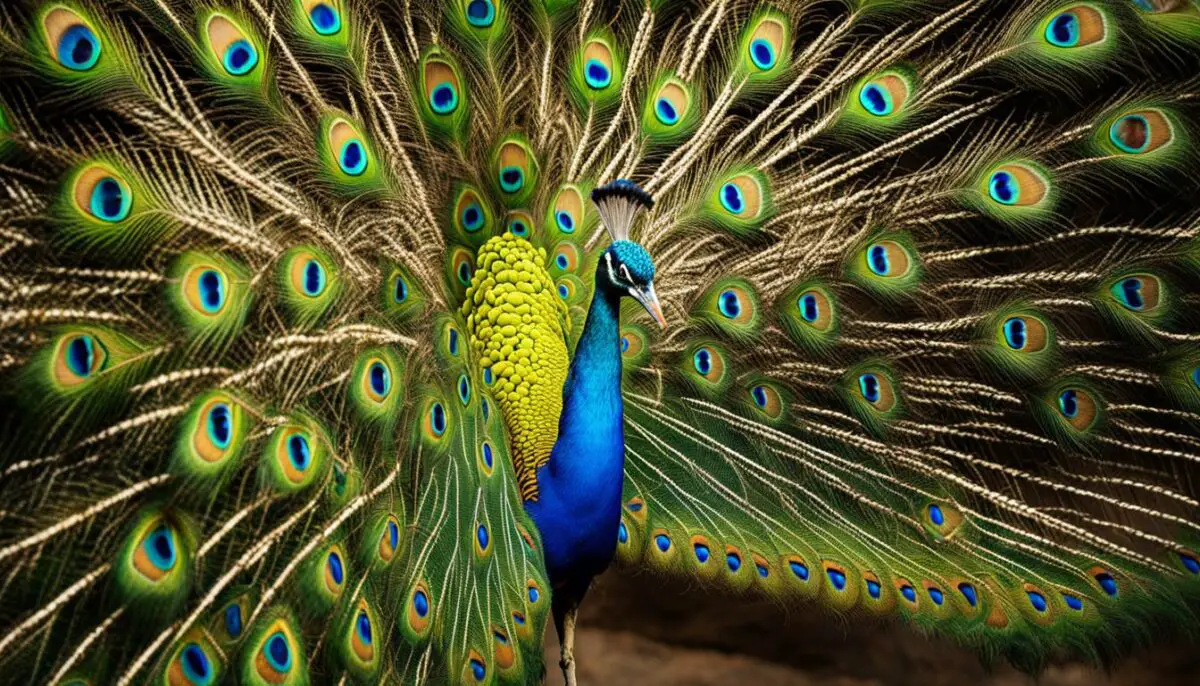Have you ever wondered why peacocks scream? These majestic birds are known for their vibrant feathers and elaborate mating dances, but their loud vocalizations often capture our attention as well. In this article, we will explore the fascinating world of peacock vocalizations and uncover the reasons behind their distinctive screams.
Key Takeaways:
- Male peacock tails produce low-pitched, loud sounds when they vibrate, which is a crucial part of their mating behavior.
- Peacocks use their screams to communicate with potential mates and establish their dominance in their territory.
- Peacock vocalizations are produced through the vibrations of their tail feathers, which act as resonators.
- Peacock screams include both audible sounds and infrasound below the range of human hearing.
- Studying peacock vocalizations helps expand our understanding of non-human communication in the animal kingdom.
The Science Behind Peacock Screams
Peacock mating cries and vocal communication are fascinating subjects that have attracted the attention of scientists. Through the use of digital bioacoustics technology, researchers have been able to delve into the science behind these distinctive vocalizations and gain new insights into peacock behaviors.
One of the key findings is that peacocks produce infrasound, which is sound below the range of human hearing. The use of infrasonic frequencies serves multiple purposes for peacocks. Firstly, infrasound is inaudible to some potential predators, allowing peacocks to communicate with potential rivals and protect their territory without making themselves a target.
Infrasound can also play a role in attracting females. It reinforces the size of the peacock’s tail as a signal of strength and genetic fitness. In landscapes where peacocks normally live, high-pitched calls are muffled over short distances, but low-frequency infrasound can travel much farther.
Further research has revealed that the biomechanics of the peacock’s tail feathers contribute to the production of these screams. The tail feathers act as resonators and amplifiers, enabling the peacock to create the low-frequency sounds that are characteristic of their vocalizations. This unique combination of vocalization and visual display enhances the peacock’s ability to communicate and establish dominance in the peafowl community.
| Peacock Vocalizations | Purpose |
|---|---|
| Peacock screams | Attracting mates and establishing dominance |
| Infrasound production | Communication with potential rivals and protection of territory |
| Tail feather vibrations | Creation of low-frequency sounds |
The Role of Peacock Tail Feathers in Vocalization
When it comes to peacock vocalizations, the role of their iconic tail feathers cannot be overlooked. The biomechanics of the peacock’s tail enable it to act as a resonator, amplifying the low-frequency sounds that are characteristic of their screams. As the peacock vibrates its tail feathers, it creates the vibrations necessary to produce these loud infrasonic vocalizations.
The size and vibrational properties of the tail feathers contribute to the production of these sounds. Acting as amplifiers, the tail feathers enhance the intensity and projection of the peacock’s vocalizations. This allows their screams to be more audible over a larger distance, ensuring that they can communicate effectively with potential mates and establish dominance in their territory.
It’s truly fascinating how the peacock’s tail feathers play such a crucial role in their vocal communication. These feathers not only serve as a visual display of beauty during their famous mating dance but also contribute to the production of their distinct and powerful vocalizations. This unique combination of visual and auditory signals makes peacocks truly captivating creatures in the animal kingdom.
Table: Comparing Different Features of Peacock Vocalizations
| Feature | Peacock Vocalizations |
|---|---|
| Sound Frequency | Infrasound (below human hearing range) |
| Sound Production | Vibrations of tail feathers |
| Amplification | Contribution of tail feathers as resonators |
| Purpose | Communication with potential mates and establishment of dominance |
As can be seen in the table above, peacock vocalizations are characterized by their infrasonic frequency range, which is below the human hearing threshold. These vocalizations are produced through the vibrations of the peacock’s tail feathers, which act as resonators to amplify the sounds. This unique combination of factors allows peacocks to effectively communicate with other peafowl and assert their dominance in their territory.
Peacock Vocalizations and Communication Among Peafowl
Peacock vocalizations play a crucial role in communication among peafowl. These loud and distinctive screams serve multiple purposes, including establishing dominance and defending territory. When a peacock screams, it signals its presence to both potential rivals and potential mates. The vocal display of a peacock is a way for it to assert its dominance and attract a mate.
Peahens, the female counterparts of peafowl, also use vocalizations to communicate with males during courtship. In fact, peacock screams can be a determining factor for peahens when choosing a mate. The loud and resonant calls of peacocks can be heard from long distances, allowing peahens to locate and evaluate potential partners. The vocalizations of peacocks serve as an advertisement of their strength and genetic fitness, making them more attractive to peahens.
Overall, peacock vocalizations are an essential part of peafowl communication. These screams not only indicate the presence and dominance of a peacock but also play a crucial role in courtship and mate selection. The loud and distinctive nature of these calls ensures that potential mates and rivals are well aware of a peacock’s territory and intentions.

| Vocalization Purpose | Importance |
|---|---|
| Establishing Dominance | Signals dominance and territorial boundaries to potential rivals |
| Defending Territory | Warns off intruders and protects the peacock’s territory |
| Attracting Mates | Peahens use vocalizations to evaluate potential mates and make their selection |
| Courtship Communication | Allows peahens to communicate with males during the courtship process |
Peacock Scream Response in Peafowls
Studies have shown that both peahens and peacocks respond to peacock screams. When infrasonic sounds made by peacocks are played back to peahens and peacocks, they become more alert and engage in more physical activity like walking and running. Males often call out in response to the sounds and even face off against the playback speaker as if it were a competitor. This response suggests that peacock screams have a significant impact on the behavior and communication of peafowls.
Peacock screams play a crucial role in establishing dominance and defending territory. When peacocks hear the screams of other males, they perceive it as a challenge and respond with their own calls, asserting their dominance and warning off potential rivals. Peahens also respond to peacock screams, indicating that these vocalizations are a key factor in their mate selection process. The heightened alertness and physical activity observed in response to peacock screams demonstrate the powerful and influential nature of these vocalizations in the peafowl community.
Peacock scream response is not limited to audible frequencies. Peafowls also react to infrasonic sounds produced by peacocks, which are below the range of human hearing. The ability of peafowls to detect and respond to infrasonic vocalizations highlights their acute auditory senses and their reliance on low-frequency communication. This unique form of communication sets peafowls apart from many other species and further contributes to their captivating and enigmatic nature.
| Peafowl Response to Peacock Screams | Behavior |
|---|---|
| Peahens | Become more alert and engage in physical activity |
| Peacocks | Respond with their own calls and face off against the playback speaker |
The response to peacock screams in peafowls underscores the significance of vocal communication in their social interactions. The ability to detect and interpret these vocalizations plays a vital role in mate selection, territory defense, and establishing dominance within the peafowl community. Further research into the intricacies of peafowl vocal communication will provide valuable insights into the fascinating world of these magnificent birds.
Peacock Vocalizations Beyond Human Hearing Range
Peacock vocalizations extend beyond the range of human hearing and encompass a variety of sounds, including infrasound and ultrasound. While we are unable to perceive these vocalizations with our ears, they serve important purposes in the peacock’s communication repertoire. By emitting infrasonic calls, peacocks can establish dominance and defend their territory against potential rivals. These low-frequency sounds, which are below the range of human hearing, enable peacocks to project their presence over long distances, ensuring their territorial boundaries are well-established.
In addition to infrasound, some animal species, including peacocks, utilize ultrasound for communication. Ultrasonic vocalizations are high-frequency sounds that are above the range of human hearing. While the exact purpose of ultrasound in peacocks is still being studied, it is believed to play a role in attracting potential mates and reinforcing the size and strength of the peacock’s tail. These high-frequency calls may also serve to communicate with other animals, such as bats or insects, which are capable of perceiving ultrasound.
Infrasound and Ultrasound: A Comparison
Table: Comparison of Infrasound and Ultrasound in Animal Vocalizations
| Category | Infrasound | Ultrasound |
|---|---|---|
| Hearing Range | Below the range of human hearing | Above the range of human hearing |
| Purposes | Establish dominance, defend territory, attract mates | Attract mates, communicate with other species |
| Example Animals | Peacocks, whales, elephants | Bats, dolphins, insects |
“Peacocks utilize vocalizations beyond what humans can hear, employing infrasound and ultrasound to communicate and interact with their environment. These unique vocalizations highlight the diversity and complexity of non-human communication in the animal kingdom.”
Peacock vocalizations, both infrasound and ultrasound, are fascinating examples of the extensive range of sounds produced by animals beyond the scope of human perception. By studying these vocalizations, scientists can gain insights into the intricate ways in which animals communicate, establish dominance, attract mates, and interact with their environment. Further research into peacock vocalizations and other animal vocalizations beyond human hearing range may continue to unveil the hidden complexities of non-human communication.
Vocal Labels and Communication in Non-Humans
Peacocks are not the only animals that utilize vocal labels and symbolic communication. Research has revealed that dolphins, cetaceans, hyraxes, wolves, and bats also employ vocal labels to individually identify themselves. These vocal labels function as a form of “names” that individuals and their communities recognize. Similarly, other animals such as prairie dogs, vervet monkeys, and elephants have been found to use vocalizations that communicate specific information, such as describing shapes, colors, or danger levels.
“The communication systems of non-human animals are far more complex than previously understood. From dolphins to bats, these creatures have their own unique ways of conveying information and establishing identities within their communities.”
Further studies have shown that non-human communication involves intricate patterns and nuanced signals. Bats, for example, possess complex social structures and use vocalizations to communicate a range of information, including identity, age, social status, and activity. Previous assumptions that primates could only produce simple calls have been debunked by bioacoustic research, revealing a greater depth and complexity of communication in various species.
Peacock Vocalizations in Context

Peacock vocalizations, including their distinctive screams and calls, are part of a broader spectrum of communication among animals. While peacocks employ their vocalizations to attract mates and assert dominance, research into non-human communication has revealed a wealth of communication strategies across different species. From vocal labels to descriptions of danger, animals utilize auditory cues to convey specific information and navigate their environments.
| Species | Communication Method |
|---|---|
| Dolphins | Vocal labels to identify individuals |
| Bats | Complex vocalizations for social communication |
| Prairie Dogs | Vocalizations describing shapes, colors, and danger levels |
| Elephants | Sonar-like vocalizations to warn of potential threats |
These examples highlight the diverse range of communication systems and their significance in understanding the complex lives of non-human animals. By expanding our knowledge of vocalizations and communication beyond human capacities, we gain a deeper appreciation for the rich tapestry of languages spoken in the animal kingdom.
The Complexity of Non-Human Communication
Non-human communication is a fascinating and intricate aspect of the animal kingdom. It goes beyond simple vocalizations and involves a variety of signals, including visual displays, olfactory cues, and even ultrasonic and infrasonic sounds. Peacock vocalizations, such as their distinctive screams, are just one example of the complexity of non-human communication. Through digital bioacoustics research, scientists have discovered that animals like bats, dolphins, and wolves utilize a range of vocal signals to convey information about identity, social status, and activity.
Studies have shown that these vocalizations are not merely random sounds, but rather deliberate forms of communication. For example, research on bats has revealed that different vocalizations serve different purposes, such as navigation, foraging, and social interactions. Similarly, dolphins use signature whistles as a form of vocal labeling, allowing individuals to recognize and communicate with each other. Peacock screeching and other vocalizations are part of a complex system of communication that extends beyond our understanding.
Furthermore, the advancements in digital bioacoustics have enabled scientists to delve deeper into the study of non-human communication. By analyzing the acoustic properties of vocal signals, researchers can decipher the meaning and intention behind these sounds. This research has led to a better understanding of the intricate communication systems present in various species. It has also challenged our assumptions about the limitations of non-human communication, revealing a rich and nuanced language that exists alongside our own.
The Role of Vocalizations in Animal Behavior
Peacock vocalizations and other forms of communication play a vital role in the behavior and social dynamics of various animal species. Vocal signals are used to establish dominance, attract mates, and communicate information about resources and threats. For example, peacocks use their screams to assert their dominance and defend their territory, while also attracting peahens during courtship. These vocalizations serve as a way to convey information and maintain social cohesion within a given community.
Insights into the Language Capacity of Non-Humans
The study of non-human communication has shed light on the language capacity of animals and expanded our understanding of their cognitive abilities. While language, as we understand it, may be unique to humans, the intricate communication systems found in other species challenge our definition of language and cognition. By exploring the complexity of non-human vocalizations and the behavioral context in which they occur, scientists aim to unravel the mysteries of animal communication and gain insights into the broader cognitive abilities of non-human beings.
Ultimately, the complexity of non-human communication highlights the vast diversity of life on Earth and invites us to reevaluate our relationship with other species. By appreciating the intricate languages of animals, we can foster a deeper understanding and respect for the rich tapestry of communication that exists in the natural world.
The Interspecies Communication Divide
As our understanding of non-human communication expands, researchers are delving into the possibility of bridging the communication divide between humans and other species. Efforts are being made to decode and comprehend the languages of animals such as sperm whales, elephants, and honeybees using artificial intelligence and digital technologies. While the notion of language in non-humans remains controversial, ongoing research suggests that there is a continuum of communication abilities across different species.
Understanding the vocalizations and reasons for peacock screams is just one piece of the puzzle. Scientists aim to unravel the intricacies of non-human communication to deepen our comprehension of the animal kingdom’s rich language systems. The use of digital bioacoustics and advanced technologies allows us to analyze and decipher the various sounds produced by different species.
Peacock vocalizations, specifically their screams, serve crucial purposes such as communication with potential mates and establishing dominance. By studying the complexities of peacock vocalizations, we gain insights not only into their behavior but also into the broader field of animal communication. These findings contribute to our understanding of the diverse vocal communication systems that exist beyond human hearing.

Exploring the Possibilities
The exploration of interspecies communication brings forth exciting possibilities. Researchers seek to develop a deeper understanding of the unique languages utilized in the animal kingdom and whether there are commonalities that bridge the gap between species. By recognizing and decoding the diverse vocalizations present in non-human creatures, we can build bridges of communication and potentially establish new forms of connection and understanding.
Conclusion
In conclusion, peacock vocalizations and calls play a vital role in their communication and behavior. The low-pitched yet loud screams produced by peacocks serve multiple purposes, including attracting potential mates and establishing dominance in their territory.
Peacock vocalizations are made possible through the vibrations of their tail feathers, which act as resonators and amplify the sounds. This unique ability allows peacocks to produce both audible calls and infrasound, which is below the human hearing range.
Through digital bioacoustics research, scientists have gained valuable insights into the complexity of non-human communication. This research has not only expanded our understanding of peacock vocalizations but has also revealed the fascinating variety of sounds produced by different species.
While the question of whether non-humans possess language remains open, the exploration of peacock screams and other forms of vocal communication in the animal kingdom continues to unravel the mysteries of non-human communication. With further advancements in technology, we may gain even deeper insights into the remarkable world of peacock vocalizations and calls.
FAQ
Why do peacocks scream?
Peacocks scream as a form of communication with potential mates and to establish dominance.
How do peacocks produce vocalizations?
Peacocks produce vocalizations through the vibrations of their tail feathers, which act as resonators and amplify the sounds.
Do peacocks make sounds that are inaudible to humans?
Yes, peacocks produce infrasound, which is sound below the range of human hearing.
What is the purpose of peacock screams?
Peacock screams serve to attract potential mates and signal dominance to rivals.
How do peacock screams affect other peafowls?
Peahens and peacocks both respond to peacock screams, becoming more alert and engaging in physical activities.
Do other animals produce vocalizations beyond human hearing?
Yes, many animals, such as whales, elephants, and tigers, use infrasound for communication and other purposes.
Do peacocks use vocal labels like other animals?
Peacocks do not use vocal labels, but other animals like dolphins and wolves have been found to use vocalizations as “names” to identify individuals.
How complex is non-human communication?
Non-human communication is more complex than previously thought, with animals like bats and primates using vocalizations to convey detailed information.
Can humans communicate with other species?
Efforts are being made to bridge the communication divide between humans and other species using digital technologies, but the extent of interspecies communication is still being explored.
What have scientists discovered about peacock vocalizations?
Scientists have discovered that peacock screams serve multiple purposes, including communication with potential mates and establishing dominance.


